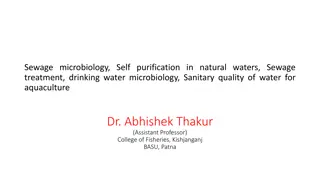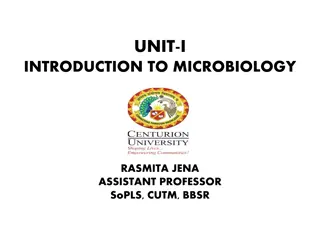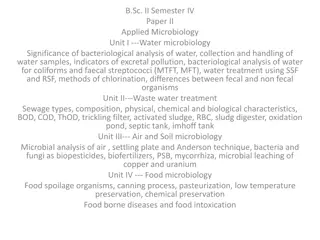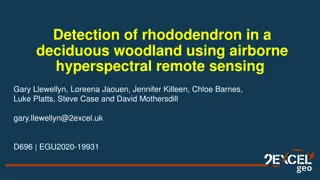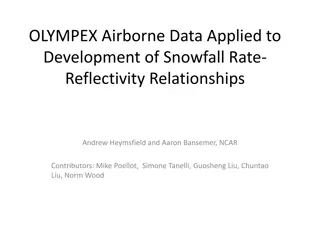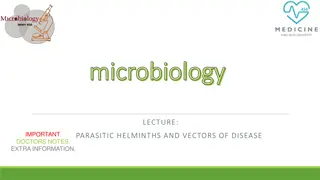Importance of Aero-Microbiology in Understanding Airborne Diseases
Aero-microbiology focuses on studying living microbes suspended in the air, with a particular emphasis on sources of microorganisms in the atmosphere. Airborne transmission of diseases through droplets and infectious dust is explored, highlighting the risks and factors affecting pathogenic microorganisms present in the air. The field of aero-microbiology plays a crucial role in understanding and preventing the spread of airborne diseases.
Uploaded on Oct 06, 2024 | 1 Views
Download Presentation

Please find below an Image/Link to download the presentation.
The content on the website is provided AS IS for your information and personal use only. It may not be sold, licensed, or shared on other websites without obtaining consent from the author. Download presentation by click this link. If you encounter any issues during the download, it is possible that the publisher has removed the file from their server.
E N D
Presentation Transcript
Microbiology of Air Class: II M.Sc MICROBIOLOGY Dr. H. VAJIHA BANU Assistant Professor Department of Microbiology Jamal Mohamed College (Autonomous) Tiruchirappalli-620 020
CONTENTS: Aero-microbiology Airborne diseases. Sources of microorganisms in Air Microbes in atmosphere Bioaerosol
Aero-microbiology: Definition: Studyof living microbes suspended in air Various layers present in the atmosphere at height of 1000km Nearest to earth is troposphere troposphere contains heavy load of microorganisms
Sources of microorganisms in air: Number of microorganisms in atmosphere but air is not a natural environment for microorganisms becauseit does not contain enoughmoisture and nutrient Soil sources of microorganisms: Diggingand ploughingthe soil Windblow Water sources of microorganisms: Splashing of water by wind action Microorganismsare discharged out in three different forms Basis on their relative size Moisturecontent
Air born transmission: Droplet: Droplets formed by sneezing, coughingand talking It consists of saliva and mucous It contains hundredof micro organisms which may be pathogenic mostly respiratory track origins Size depend of duration of time Pathogenic microorganisms may be a source of infectious disease Droplet of nuclei: small droplets in warm and dry atmosphere evaporate rapidlyand becomedroplet nuclei Size 1-4 m Factors atmospheric conditions like humidity, sunlight and temperature No of bacteria in a single sneeze between 10000-100000
Air born transmission: Infectious dust: Large aerosol droplets settle out rapidly from air Nasal and throat discharge from a patient Air born diseases transmitted by two droplets, dependingupontheir size Droplets larger than 100umin diameter Dried residues of droplets
Air borne microbial diseases: Bacterial diseases: Brucellosis: occupationaldisease amongslaughter house workers Pulmonary Anthrax: transmission by contaminated animal products Streptococcus pyogenes: throat and skin disease Rheumatic fever: inflammation and degeneration of heart valves Streptococcal pneumonia: Meningitis: commonin children Diphtheria: infection of tonsils, throat and nose Tuberculosis: respiratory disease Legionellosis: cause by natural water contamination
Air borne microbial diseases: Fungaldiseases: Cryptococcosis:caused by inhalationof soil particles Blastomycosis: lesion formation Coccidioidomycosis:influenza fever Aspergillosis:disease of human Viraldiseases: Commoncold:droplets from nose Influenza: nasal discharge, headache, muscle pains, sore throat Measles: red blotchyskin rash Mumps: swelling of parotid gland and salivary glands Adeno viral diseases: acute respiratory disease and eye infection
Microbes in atmosphere: The atmosphericlayer are importantforces in determining viable particles in air Aero microbiological pathways AMP The layer of most interest and significance is the boundary layer that is 0.1km from earth surface Boundary layer responsible for transport of particles both short and long distances Boundary layerconsist of three parts First layer:laminar boundary layer Secondlayer: turbulentboundary layer Third layer: local eddy layer
Dispersal of microbes in atmosphere: Dispersal begins with discharge of microbial cell, spores to the atmosphere Particles transport via diffusion, dispersion and deposition Example: liquid aerosol containing influenza virus Deposition of microorganisms occurs through three processes launching transport and deposition
Bioaerosol: Definition: particles release from terrestrial and marine ecosystem into the atmosphere they consist of both living and non living components including organisms, dispersal methodof organisms and excretion Mist of dust micrometerin range General range from 0.02-100 um in diameter Classification on basis of size: Smaller particle <0.1um in diameterare in nuclei mode Particle 0.1-2um are in accumulationmode Larger particlesare coarse mode
Launching: Definition: The process whereby microbes loaded particles become suspended within the earth s atmosphere is termed launching factors: Air turbulence Waste materials Natural mechanicalprocess Releaseof fungal spores Sources: terrestrial and aquatic Instantaneous point sources Continuous point sources
Bioaerosol transport: Transport is the process by which a viable particles move from one point to another Sub microscale transport involves short period of time 10mints under 100m Micro transportranges10mints to 1 hour and 100m to 1km Estimation by using Osbert Reynolds method Re = velocity x dimension viscosity
Bioaerosol deposition: 1 Gravitationalsittings: Microbial particles that are exposed to wind above 8 x 103m/hrs then gravitational deposition may be negligible 2 Downward moleculardiffusion: Natural air currents Force of winds Depositionrate 3 Surface impaction: Particles make contact with surfaces such as leaves, tree, wall and furniture Causes: Allow downward molecular diffusion and gravitational setting Allow particles to escape the surface Regardedas the Last step in AMB pathway Rate of deposition of a particle is directly proportional to its mass, volume and mass/volume ratio
Bioaerosol deposition: 4.Rain and electrostatic deposition: Rainfall occurs as a condensation reaction b/w two particles which combine and create bioaerosol with a greater mass making it to settle faster Microorganism have negative chargedue to which they associates with positive chargedair borne particles resulting in electrostatic condensation
THANK YOU THANK YOU


















